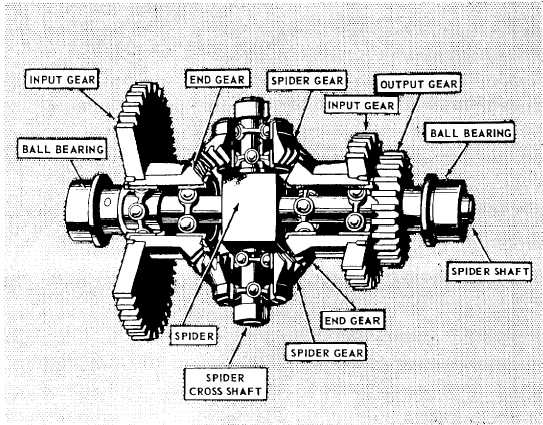Figure 11-8.-Bevel gear differential.
slightly curved bars, plates, or leaves. They also include
special flat springs (fig. 11-7, A [3]), made from a flat
strip or bar formed into whatever shape or design best
suited for a specific position and purpose.
Spiral Springs
Spiral springs are sometimes called clock, power
(1 1-7, B), or coil springs. A well-known example is a
watch or clock spring; after you wind (tighten) it, it
gradually unwinds and releases power. Although other
names for these springs arc based on good authority, we
call them “spiral” in this text to avoid confusion.
Helical Springs
Helical springs, also often called spiral (fig. 11-7,
D), are probably the most common type of spring. They
may be used in compression (fig. 11-7, D [1]), extension
or tension (fig. 11-7, D [2]), or torsion (fig. 11-7, D [3]).
A spring used in compression tends to shorten in action,
while a tension spring lengthens in action. Torsion
springs, which transmit a twist instead of a direct pull,
operate by a coiling or an uncoiling action.
In addition to straight helical springs, cone,
double-cone, keg, and volute springs are classified as
helical. These types of springs are usually used in
compression. A cone spring (11-7, D [4]), often called a
valve spring because it is frequently used in valves, is
formed by wire being wound on a tapered mandrel
instead of a straight one. A double cone spring (not
illustrated) consists of two cones joined at the small
ends, and a keg spring (not illustrated) consists of two
cone springs joined at their large ends.
Volute springs (fig. 11-7, D [5]) are conical springs
made from a flat bar that is wound so that each coil
partially overlaps the adjacent one. The width (and
thickness) of the material gives it great strength or
resistance.
You can press a conical spring flat so that it requires
little space, and it is not likely to buckle sidewise.
11-6


